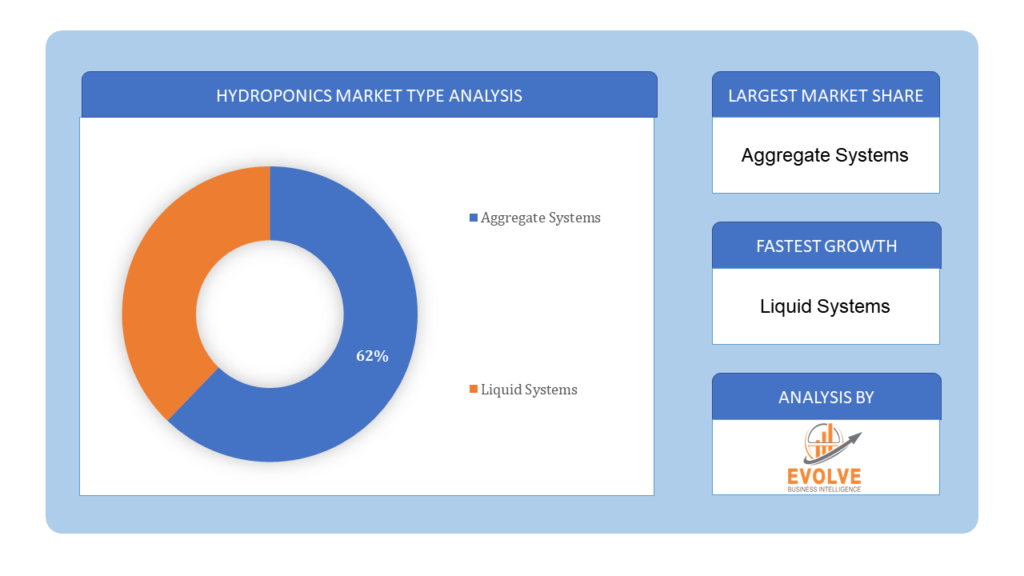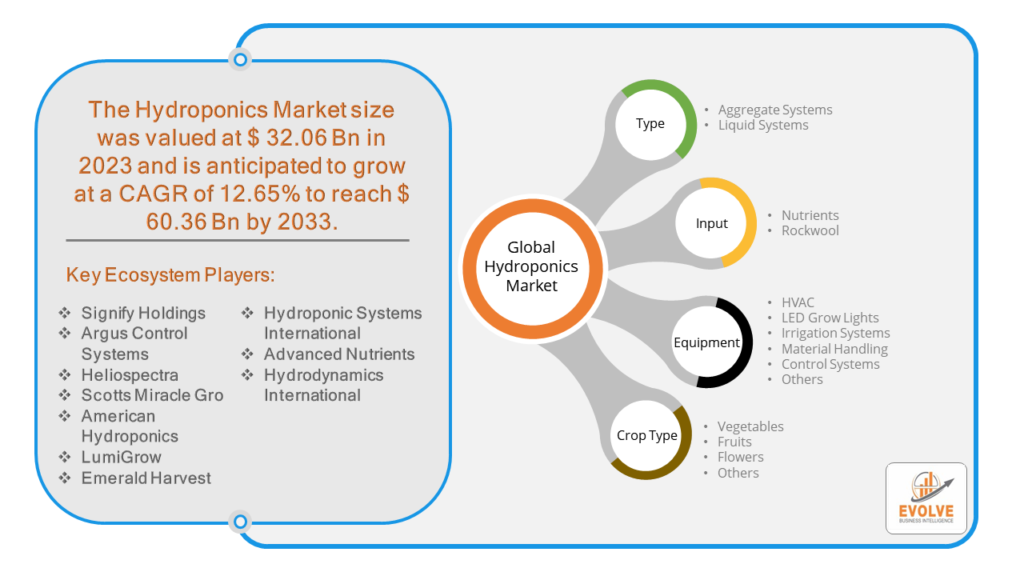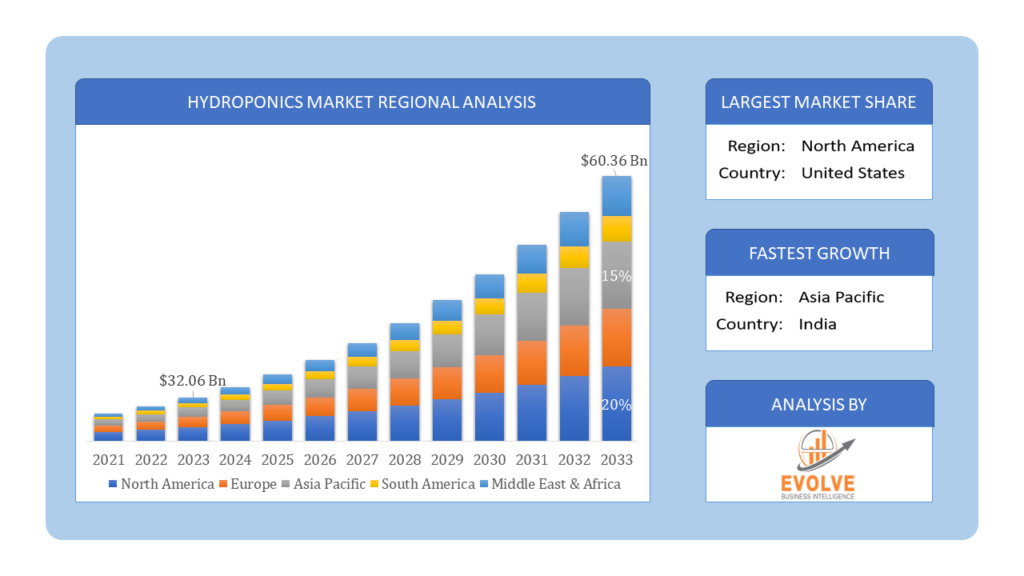Hydroponics Market Analysis and Global Forecast 2023-2033
$1,390.00 – $5,520.00Price range: $1,390.00 through $5,520.00
Hydroponics Market Research Report: By basis of Type (Aggregate Systems, Liquid Systems), By Basis Of Input (Nutrients, Rockwool), By basis of equipment (HVAC, LED Grow Lights, Irrigation Systems, Material Handling, Control Systems, Others), By Crop Type (Vegetables (Fruits, Flowers, Others))), and by Region — Forecast till 2033
Page: 140
[vc_row][vc_column width=”2/3″][vc_column_text text_larger=”no” woodmart_inline=”no”]
Hydroponics Market Overview
Hydroponics Market Size is expected to reach USD 60.36 Billion by 2033. The Hydroponics industry size accounted for USD 32.06 Billion in 2023 and is expected to expand at a compound annual growth rate (CAGR) of 12.65% from 2023 to 2033. The hydroponics market refers to the industry involved in the cultivation of plants without soil, using nutrient solutions in a water-based system. This innovative agricultural technique has ancient roots and offers numerous benefits, including faster plant growth, high yields, and the ability to grow plants in various locations like rooftops and greenhouses. Hydroponics allows for water and nutrient recycling, organic food production, and is even utilized in space research programs. Despite its advantages, hydroponics requires upfront investment and technical knowledge. Overall, the hydroponics market is a growing sector that revolutionizes traditional farming methods by providing a soil-less and efficient way to cultivate a variety of crops.
Global Hydroponics Market Synopsis
The Hydroponics market experienced a detrimental effect due to the Covid-19 pandemic. Due to supply chain disruptions brought on by the COVID-19 epidemic, there are now shortages or decreased demand in the hydroponics market. Spending by consumers and businesses has decreased significantly as a result of the travel restrictions and social distancing measures, and this trend is expected to persist for some time. The epidemic has altered end-user trends and tastes, prompting manufacturers, developers, and service providers to implement diverse tactics aimed at stabilizing their businesses.
Global Hydroponics Market Dynamics
The major factors that have impacted the growth of Hydroponics are as follows:
Drivers:
⮚ Climate Change
Erratic weather patterns and climate change-related challenges such as droughts and floods affect traditional farming practices. Hydroponics provides a controlled environment where variables like temperature, humidity, and light can be optimized, reducing the impact of climate change on crop yields.
Restraint:
- High Initial Investment Costs
Setting up a hydroponic system requires significant initial investment in infrastructure, technology, and skilled labor. The capital expenditure can be a barrier for small-scale farmers or those operating in developing regions with limited access to financing.
Opportunity:
⮚ Technology Integration
Integration of advanced technologies such as artificial intelligence, machine learning, and Internet of Things (IoT) in hydroponic systems can optimize resource utilization, automate operations, and improve crop yields. Smart hydroponic systems equipped with sensors and data analytics capabilities enable real-time monitoring and precise control of environmental factors, leading to more efficient and sustainable production practices.
Hydroponics Market Segment Overview
By Type
 Based on the Type, the market is segmented based on Aggregate Systems and Liquid Systems. According to hydroponics market data, the aggregate systems category held the lion’s share in 2022. This is because it is inexpensive, simple to set up, and widely accepted by indoor hydroponic growers. The plants in these systems are supported by inert and solid medium like as peat, rock wool, vermiculite, sand, sawdust, perlite, or coconut coir.
Based on the Type, the market is segmented based on Aggregate Systems and Liquid Systems. According to hydroponics market data, the aggregate systems category held the lion’s share in 2022. This is because it is inexpensive, simple to set up, and widely accepted by indoor hydroponic growers. The plants in these systems are supported by inert and solid medium like as peat, rock wool, vermiculite, sand, sawdust, perlite, or coconut coir.
By Input
Based on Input, the market has been divided into Nutrients and Rockwool. During the 2022–2030 forecast period, the nutrients segment is expected to develop at a faster rate than other segments, having led market growth in 2022. This segment’s significant market share can be attributed to the need to cultivate crops in both aggregate and non-aggregate approaches. The three essential nutrients that plants need to grow are potassium, phosphorus, and nitrogen.
By Equipment
Based on the Equipment, the market has been divided into HVAC, LED Grow Lights, Irrigation Systems, Material Handling, Control Systems, Others. In the hydroponics market, the Equipment segment encompasses a wide range of essential tools and systems, including grow lights, hydroponic systems (such as deep water culture and nutrient film technique), pumps, reservoirs, and controllers. This segment is witnessing steady growth driven by technological advancements, increasing adoption of indoor farming practices, and the rising demand for efficient, automated hydroponic solutions.
By Crop type
Based on Crop type, the market has been divided into Vegetables (Fruits, Flowers, Others). This segment is experiencing significant growth attributed to the rising demand for fresh, locally grown produce, increased consumer awareness about food quality and safety, and the ability of hydroponic systems to optimize growing conditions for a wide range of crops, regardless of seasonal constraints.
Global Hydroponics Market Regional Analysis
Based on region, the market has been divided into North America, Europe, Asia-Pacific, the Middle East & Africa, and Latin America. The area of Europe is anticipated to dominate the market for the usage of Hydroponics, followed by those in Asia-Pacific and North America.
 Hydroponics Europe Market
Hydroponics Europe Market
The Europe region holds a dominant position in the Hydroponics market. The hydroponics market in Europe, which was valued at USD 1.145 billion in 2022 and held a 45.80% market share, is anticipated to develop at a substantial compound annual growth rate (CAGR) throughout the course of the study. It can be linked to the growing industrialization and scarcity of land that have led to the widespread use of hydroponics. Europe is home to the developed economies of the Netherlands, Greece, Italy, France, and Spain. The rapid development of genetically modified agricultural technologies is another factor expected to contribute to the region’s substantial CAGR during the forecast period.
Hydroponics Asia Pacific Market
The Asia-Pacific region is witnessing rapid growth and emerging as a significant market for the Hydroponics industry. The hydroponics market in Asia Pacific is anticipated to expand at the quickest rate possible between 2022 and 2030. This can be explained by the fact that hydroponics is widely used in countries like South Korea, Australia, China, and others. It is projected that the market in China and India would develop significantly over the forecast period due to the emergence of urban hydroponic farms. North America has enormous development potential because of the sheer number of firms that are located there.
Competitive Landscape
The competitive landscape includes key players (tier 1, tier 2, and local) having a presence across the globe. Companies such as Signify Holdings, Argus Control Systems, Heliospectra, Scotts Miracle Gro, and American Hydroponics are some of the leading players in the global Hydroponics Industry. These players have adopted partnership, acquisition, expansion, and new product development, among others as their key strategies.
Key Market Players:
- Signify Holdings
- Argus Control Systems
- Heliospectra
- Scotts Miracle Gro
- American Hydroponics
- LumiGrow
- Emerald Harvest
- Hydroponic Systems International
- Advanced Nutrients
- Hydrodynamics International
Key Development:
On July 2022: The largest hydroponic farm in the world, supported by a USD 40 million investment, has officially opened its doors in Bustanica. The facility is the one of the first vertical farm for Emirates Crop One, a partnership between Crop One, a pioneer in technology-driven indoor vertical farming, and Emirates Flight Catering (EKFC), one of the largest catering companies in the world, serving more than 100 airlines.
Scope of the Report
Global Hydroponics Market, by Type
- Aggregate Systems
- Liquid Systems
Global Hydroponics Market, by Input
- Nutrients
- Rockwool
Global Hydroponics Market, by Equipment
- HVAC
- LED Grow Lights
- Irrigation Systems
- Material Handling
- Control Systems
- Others
Global Hydroponics Market, by Crop type
- Vegetables
- Fruits
- Flowers
- Others
Global Hydroponics Market, by Region
- North America
- US
- Canada
- Mexico
- Europe
- UK
- Germany
- France
- Italy
- Spain
- Benelux
- Nordic
- Rest of Europe
- Asia Pacific
- China
- Japan
- South Korea
- Indonesia
- Austalia
- Malaysia
- India
- Rest of Asia Pacific
- South America
- Brazil
- Argentina
- Rest of South America
- Middle East & Africa
- Saudi Arabia
- UAE
- Egypt
- South Africa
- Rest of Middle East & Africa
| Parameters | Indicators |
|---|---|
| Market Size | 2033: $60.36 Billion |
| CAGR | 12.65% CAGR (2023-2033) |
| Base year | 2022 |
| Forecast Period | 2023-2033 |
| Historical Data | 2021 |
| Report Coverage | Revenue Forecast, Competitive Landscape, Growth Factors, and Trends |
| Key Segmentations | Type, Input, Equipment, Crop type |
| Geographies Covered | North America, Europe, Asia-Pacific, Latin America, Middle East, Africa |
| Key Vendors | Signify Holdings, Argus Control Systems, Heliospectra, Scotts Miracle Gro, American Hydroponics, LumiGrow, Emerald Harvest, Hydroponic Systems International, Advanced Nutrients, Hydrodynamics International |
| Key Market Opportunities | liquid systems sector |
| Key Market Drivers | The rising population to increasing the demand for food |
REPORT CONTENT BRIEF:
- High-level analysis of the current and future Hydroponics Industry trends and opportunities
- Detailed analysis of current market drivers, restraining factors, and opportunities analysis in the future
- Historical market size for the year 2021, and forecast from 2023 to 2033
- Hydroponics market share analysis for each segment
- Competitor analysis with a comprehensive insight into its product segment, financial strength, and strategies adopted.
- Identifies key strategies adopted by the key players including new product development, mergers and acquisitions, joint ventures, collaborations, and partnerships.
- To identify and understand the various factors involved in the global Hydroponics market affected by the pandemic
- To provide year-on-year growth from 2022 to 2033
- To provide short-term, long-term, and overall CAGR comparison from 2022 to 2033.
- Provide Total Addressable Market (TAM) for the Global Hydroponics Market.
[/vc_column_text][/vc_column][vc_column width=”1/3″][vc_column_text text_larger=”no” woodmart_inline=”no”][html_block id=”3961″][/vc_column_text][vc_wp_text]
Press Release
[rpwe limit=”10″ thumb=”true”][/vc_wp_text][/vc_column][/vc_row][vc_row][vc_column][vc_column_text woodmart_inline=”no” text_larger=”no”]
Frequently Asked Questions (FAQ)
[/vc_column_text][vc_column_text woodmart_inline=”no” text_larger=”no”][sp_easyaccordion id=”12727″][/vc_column_text][/vc_column][/vc_row]




